Spatial Analysis and Risk Assessment of Meteorological Disasters Affecting Cotton Cultivation in Xinjiang: A Comprehensive Model Approach
Abstract
1. Introduction
2. Study Area and Data Sources
2.1. Study Area
2.2. Data Sources
3. Methods
3.1. Indicator System for Evaluating Meteorological Disaster Risks in Cotton
3.1.1. Definition of Hazard Indicators of Disaster-Causing Factors
3.1.2. Definition of Exposure Indicators of Disaster-Bearing Bodies
3.1.3. Definition of Vulnerability Indicators of Disaster-Bearing Body
3.2. Standardized Treatment
3.3. Weight Calculation Method
3.4. Meteorological Disaster Risk Assessment Model
3.5. Technology Roadmap
4. Results
4.1. Assessment Indicator Thresholds Determination and Weight Calculation
4.2. Hazard Evaluation of Disaster-Causing Factors
4.3. Exposure of Disaster-Bearing Bodies
4.4. Vulnerability of Disaster-Bearing Bodies
4.5. Meteorological Disaster Risk for Cotton
5. Discussion
6. Conclusions
Author Contributions
Funding
Institutional Review Board Statement
Informed Consent Statement
Data Availability Statement
Conflicts of Interest
References
- National of Bureau of Statistics of China. China Statistical Yearbook; National of Bureau of Statistics of China: Beijing, China, 2022; pp. 4–5.
- Yao, J.; Zhao, Y.; Chen, Y.; Yu, X.; Zhang, R. Multi-scale assessments of droughts: A case study in Xinjiang, China. Sci. Total Environ. 2018, 630, 444–452. [Google Scholar] [CrossRef] [PubMed]
- Editorial Department of this Journal. Build a strong security line and build a better home. Disaster Reduct. China 2022, 09, 30–33. [Google Scholar]
- Chen, B.; Chen, K.; Wang, X.; Wang, X. Spatial and Temporal Distribution Characteristics of Rainstorm and Flood Disasters around Tarim Basin. Pol. J. Environ. Stud. 2022, 31, 2029–2037. [Google Scholar] [CrossRef] [PubMed]
- Chen, Y.; Ma, Y. Spatial and temporal characteristics of flood and rainstorm disaster in Xinjiang. Arid Land Geogr. 2021, 44, 1515–1524. [Google Scholar]
- Wang, X.; Wang, X. Spatial distribution and temporal variation characteristics of rainstorm flood disasters with different intensities in southern Xinjiang from 1980 to 2019. J. Glaciol. Geocryol. 2021, 43, 1818–1828. [Google Scholar]
- Zhang, T.; Wang, H.; Yu, X. Spatial-temporal distribution of wind disasters in Xinjiang. Arid Land Geogr. 2021, 44, 1281–1289. [Google Scholar]
- Shi, L.M.; Li, B.; Li, Y.Y.; Kong, L.W.; Liu, W.P. Study on economic loss assessment and risk division of hail disaster in Xinjiang. J. Glaciol. Geocryol. 2017, 39, 299–307. [Google Scholar]
- Roxburgh, N.; Guan, D.; Shin, K.J.; Rand, W.; Managi, S.; Lovelace, R.; Meng, J. Characterising climate change discourse on social media during extreme weather events. Glob. Environ. Chang.-Hum. Policy Dimens. 2019, 54, 50–60. [Google Scholar] [CrossRef]
- Liu, K.; Harrison, M.T.; Yan, H.; Liu, D.L.; Meinke, H.; Hoogenboom, G.; Wang, B.; Peng, B.; Guan, K.; Jaegermeyr, J.; et al. Silver lining to a climate crisis in multiple prospects for alleviating crop waterlogging under future climates. Nat. Commun. 2023, 14, 765. [Google Scholar] [CrossRef]
- Impacts, Adaptation and Vulnerability, IPCC AR6 Working Group II report. Weather 2022, 77, 115.
- Zhang, Y.; Qu, H.; Yang, X.; Wang, M.; Qin, N.; Zou, Y. Cropping system optimization for drought prevention and disaster reduction with a risk assessment model in Sichuan Province. Glob. Ecol. Conserv. 2020, 23, e01095. [Google Scholar] [CrossRef]
- Xu, X.; Tang, Q. Spatiotemporal variations in damages to cropland from agrometeorological disasters in mainland China during 1978–2018. Sci. Total Environ. 2021, 785, 147247. [Google Scholar] [CrossRef] [PubMed]
- Zinat, M.R.M.; Salam, R.; Badhan, M.A.; Islam, A.R.M.T. Appraising drought hazard during Boro rice growing period in western Bangladesh. Int. J. Biometeorol. 2020, 64, 1687–1697. [Google Scholar] [CrossRef] [PubMed]
- Wang, Y.; Lv, J.; Sun, H.; Zuo, H.; Gao, H.; Qu, Y.; Su, Z.; Yang, X.; Yin, J. Dynamic agricultural drought risk assessment for maize using weather generator and APSIM crop models. Nat. Hazards 2022, 114, 3083–3100. [Google Scholar] [CrossRef]
- Xiang, K.; Wang, B.; Liu, D.L.; Chen, C.; Waters, C.; Huete, A.; Yu, Q. Probabilistic assessment of drought impacts on wheat yield in south-eastern Australia. Agric. Water Manag. 2023, 284, 108359. [Google Scholar] [CrossRef]
- Li, S.; Wang, B.; Feng, P.; Liu, D.L.; Li, L.; Shi, L.; Yu, Q. Assessing climate vulnerability of historical wheat yield in south-eastern Australia’s wheat belt. Agric. Syst. 2022, 196, 103340. [Google Scholar] [CrossRef]
- Wei, Y.; Jin, J.; Cui, Y.; Ning, S.; Fei, Z.; Wu, C.; Zhou, Y.; Zhang, L.; Liu, L.; Tong, F. Quantitative assessment of soybean drought risk in Bengbu city based on disaster loss risk curve and DSSAT. Int. J. Disaster Risk Reduct. 2021, 56, 102126. [Google Scholar] [CrossRef]
- Ma, Y.; Guga, S.; Xu, J.; Zhang, J.; Tong, Z.; Liu, X. Comprehensive Risk Assessment of High Temperature Disaster to Kiwifruit in Shaanxi Province, China. Int. J. Environ. Res. Public Health 2021, 18, 10437. [Google Scholar] [CrossRef]
- Chen, Y.; Han, X.; Si, W.; Wu, Z.; Chien, H.; Okamoto, K. An assessment of climate change impacts on maize yields in Hebei Province of China. Sci. Total Environ. 2017, 581, 507–517. [Google Scholar] [CrossRef]
- Sharma, T.; Vittal, H.; Karmakar, S.; Ghosh, S. Increasing agricultural risk to hydro-climatic extremes in India. Environ. Res. Lett. 2020, 15, 034010. [Google Scholar] [CrossRef]
- Pathak, H.; Wassmann, R. Quantitative evaluation of climatic variability and risks for wheat yield in India. Clim. Chang. 2009, 93, 157–175. [Google Scholar] [CrossRef]
- Wu, H.; Wilhite, D.A. An operational agricultural drought risk assessment model for Nebraska, USA. Nat. Hazards 2004, 33, 1–21. [Google Scholar] [CrossRef]
- Prabnakorn, S.; Maskey, S.; Suryadi, F.X.; de Fraiture, C. Assessment of drought hazard, exposure, vulnerability, and risk for rice cultivation in the Mun River Basin in Thailand. Nat. Hazards 2019, 97, 891–911. [Google Scholar] [CrossRef]
- Alonzo, C.A.; Galabay, J.M.; Macatangay, M.N.; Magpayo, M.B.; Ramirez, R. Drought Risk Assessment and Monitoring of Ilocos Norte Province in the Philippines Using Satellite Remote Sensing and Meteorological Data. Agriengineering 2023, 5, 720–739. [Google Scholar] [CrossRef]
- Song, W.; Cao, S.; Du, M.; Mo, Y.; Li, S. Investigation of compound drought risk and driving factors in Nepal. Nat. Hazards 2022, 114, 1365–1391. [Google Scholar] [CrossRef]
- Guo, H.; Wang, R.; Garfin, G.M.; Zhang, A.; Lin, D.; Liang, Q.; Wang, J. Rice drought risk assessment under climate change: Based on physical vulnerability a quantitative assessment method. Sci. Total Environ. 2021, 751, 141481. [Google Scholar] [CrossRef] [PubMed]
- Zhao, M.; Shi, X.; Sun, X.; Jin, K.; Duan, Z.; Gao, C. Risk assessment for comprehensive meteorological disaster of winter wheat based on multisource gridded data: A case study in the upper Huaihe River basin, China. Int. J. Climatol. 2022, 42, 9595–9611. [Google Scholar] [CrossRef]
- Fang, F.; Wang, J.; Lin, J.; Xu, Y.; Lu, G.; Wang, X.; Huang, P.; Huang, Y.; Yin, F. Risk Assessment of Maize Yield Losses in Gansu Province Based on Spatial Econometric Analysis. Agriculture 2023, 13, 1280. [Google Scholar] [CrossRef]
- Yuan, X.-C.; Wang, Q.; Wang, K.; Wang, B.; Jin, J.-L.; Wei, Y.-M. China’s regional vulnerability to drought and its mitigation strategies under climate change: Data envelopment analysis and analytic hierarchy process integrated approach. Mitig. Adapt. Strateg. Glob. Chang. 2015, 20, 341–359. [Google Scholar] [CrossRef]
- Pant, S.; Kumar, A.; Ram, M.; Klochkov, Y.; Sharma, H.K. Consistency Indices in Analytic Hierarchy Process: A Review. Mathematics 2022, 10, 1206. [Google Scholar] [CrossRef]
- Sahoo, M.; Sahoo, S.; Dhar, A.; Pradhan, B. Effectiveness evaluation of objective and subjective weighting methods for aquifer vulnerability assessment in urban context. J. Hydrol. 2016, 541, 1303–1315. [Google Scholar] [CrossRef]
- Wu, J.; Lin, X.; Wang, M.; Peng, J.; Tu, Y. Assessing Agricultural Drought Vulnerability by a VSD Model: A Case Study in Yunnan Province, China. Sustainability 2017, 9, 918. [Google Scholar] [CrossRef]
- Rahmati, O.; Zeinivand, H.; Besharat, M. Flood hazard zoning in Yasooj region, Iran, using GIS and multi-criteria decision analysis. Geomat. Nat. Hazards Risk 2016, 7, 1000–1017. [Google Scholar] [CrossRef]
- Yang, Z.; Gao, X.; Lei, J. Fuzzy comprehensive risk evaluation of aeolian disasters in Xinjiang, Northwest China. Aeolian Res. 2021, 48, 100647. [Google Scholar] [CrossRef]
- Pei, H.J.; Chen, J.; Li, W.; Sun, Y.P.; Chen, W.K. Spatiotemporal pattern and risk assessment of storm flood in Gansu Province. J. Nat. Disasters 2017, 26, 167–175. [Google Scholar] [CrossRef]
- Wang, Z.; Xia, N.; Zhao, X.; Ji, X.; Wang, J. Comprehensive risk assessment of typhoon disasters in China’s coastal areas based on multi-source geographic big data. Sci. Total Environ. 2024, 926, 171815. [Google Scholar] [CrossRef] [PubMed]
- Zhang, S.; Pu, Z.; Li, J. The spatial-temporal variation of sunshine duration in Xinjiang during 1961–2010. Acta Geogr. Sin. 2013, 68, 1481–1492. [Google Scholar] [CrossRef]
- Yang, J.; Huang, X. The 30 m annual land cover dataset and its dynamics in China from 1990 to 2019. Earth Syst. Sci. Data 2021, 13, 3907–3925. [Google Scholar] [CrossRef]
- Brooks, H.E.; Stensrud, D.J. Climatology of heavy rain events in the United States from hourly precipitation observations. Mon. Weather Rev. 2000, 128, 1194–1201. [Google Scholar] [CrossRef]
- Hou, Q.; Yang, L.; Zhang, X.; Xie, S.; Feng, W.; Zou, Y.; Zhang, Y. GIS-Based Risk Evaluation of Meteorological Disasters for Rice—A Case Study of Wangcang County, Guangyuan Sichuan. J. Southwest Univ. Nat. Sci. Ed. 2021, 43, 35–45. [Google Scholar] [CrossRef]
- Memeti, K. Risk Assessment of Cotton Drought Disaster in Northern Xinjiang; Xinjiang Agricultural University: Urumqi, China, 2022. [Google Scholar]
- Saaty, T.L. A scaling method for priorities in hierarchical structures. J. Math. Psychol. 1977, 15, 234–281. [Google Scholar] [CrossRef]
- Zhang, X.; Liang, C. Application of fuzzy matter-element model based on coefficients of entropy in comprehensive evaluation of water quality. J. Hydraul. Eng. 2005, 36, 1057–1061. [Google Scholar]
- Song, D.; Liu, C.; Shen, C.; Shi, X.; Zang, L.; Feng, W. Multiple objective and attribute decision making based on the subjective and objective weighting. J. Shandong Univ. Eng. Sci. 2015, 45, 1–9. [Google Scholar] [CrossRef]
- Cheng, C.; Fang, X.; Li, M.; Yang, Y.; Gao, Y.; Zhang, S.; Yu, Y.; Liu, Y.; Du, W. Rainstorm and high-temperature disaster risk assessment of territorial space in Beijing, China. Meteorol. Appl. 2023, 30, e2140. [Google Scholar] [CrossRef]
- Qing, Q.; Xu, J.; Zhou, B.; Xu, Y.; Deng, G.; Zhong, Y.; Zhang, Y. Refined risk zoning of storm and flood disasters for single cropping rice of Sichuan. J. Northwest A F Univ. Nat. Sci. Ed. 2021, 49, 31–41. [Google Scholar]
- Pei, Z. Study on Drought Disaster Monitoring and Risk Assessment of Spring Maize in Songnen Plain of Northeast China. Ph.D. Thesis, Chengdu University of Technology, Chengdu, China, 2022. [Google Scholar]
- Wang, C.; Ren, X.; Li, Y. Analysis of extreme precipitation characteristics in low mountain areas based on three-dimensional copulas-taking Kuandian County as an example. Theor. Appl. Climatol. 2017, 128, 169–179. [Google Scholar] [CrossRef]
- Wang, C.; Wu, J.; Wang, X.; He, X. Application of the hidden Markov model in a dynamic risk assessment of rainstorms in Dalian, China. Stoch. Environ. Res. Risk Assess. 2018, 32, 2045–2056. [Google Scholar] [CrossRef]
- Wu, J.; Chen, X.; Lu, J. Assessment of long and short-term flood risk using the multi-criteria analysis model with the AHP-Entropy method in Poyang Lake basin. Int. J. Disaster Risk Reduct. 2022, 75, 102968. [Google Scholar] [CrossRef]
- Chen, J.; Liu, L.; Pei, J.; Deng, M. An ensemble risk assessment model for urban rainstorm disasters based on random forest and deep belief nets: A case study of Nanjing, China. Nat. Hazards 2021, 107, 2671–2692. [Google Scholar] [CrossRef]
- Xu, Y.; Chen, L.; Liu, Y.; Li, S.; Zhou, X.; Na, R. Comparative Analysis of Natural Disaster Risk Assessment Based on Different Spatial Resolution DataTaking Rainstorm and Flood Disaster as an Example. J. Catast. 2022, 37, 61–68. [Google Scholar]
- Deng, M.; Li, Z.; Tao, F. Rainstorm Disaster Risk Assessment and Influence Factors Analysis in the Yangtze River Delta, China. Int. J. Environ. Res. Public Health 2022, 19, 9497. [Google Scholar] [CrossRef] [PubMed]
- Chen, N. Study on Meteorological Disaster Risk Assessment and Climatic Zoning in Heze City. J. Shandong Agric. Univ. Nat. Sci. 2018, 49, 257–261. [Google Scholar]
- Dai, X.; Chen, S.; Jia, K.; Jiang, H.; Sun, Y.; Li, D.; Zheng, Q.; Huang, J. A Decision-Tree Approach to Identifying Paddy Rice Lodging with Multiple Pieces of Polarization Information Derived from Sentinel-1. Remote Sens. 2023, 15, 240. [Google Scholar] [CrossRef]
- Niu, L.; Feng, S.; Ding, W.; Li, G. Influence of Speed and Rainfall on Large-Scale Wheat Lodging from 2007 to 2014 in China. PLoS ONE 2017, 11, e0157677. [Google Scholar] [CrossRef] [PubMed]
- Wang, H.; Mao, W.Y.; Li, Y.P.; Yu, X.J.; Bai, S.Q. Risk Zoning of Torrential Rain Which Easily Causes Damage in Xinjiang Region. J. Glaciol. Geocryol. 2011, 33, 1407–1413. [Google Scholar] [CrossRef]
- Lv, X.; Zhou, Y.; Yu, X.; Yu, B.; Wang, X. Temporal and spatial variation characteristics of rainstorm torrential flood disaster loss in Xinjiang during 1961–2019. Desert Oasis Meteorol. 2021, 15, 42–49. [Google Scholar]
- Tian, Y.; Yan, Z.; Li, Z. Spatial and Temporal Variations of Extreme Precipitation in Central Asia during 1982–2020. Atmosphere 2022, 13, 60. [Google Scholar] [CrossRef]
- Yang, X.; Zhou, H.; Zhao, Y.; Tang, Z.; Zhao, K. Analysis on Fine-Scale Characteristics of Summer Rainstorm in Xinjiang. Meteorol. Mon. 2021, 47, 1501–1511. [Google Scholar] [CrossRef]
- Yang, Y.; Shen, L.; Wang, B. How is the precipitation distributed vertically in arid mountain region of Northwest China? J. Geogr. Sci. 2022, 32, 241–258. [Google Scholar] [CrossRef]
- Min, Y.; Huang, W.; Ma, M.; Zhang, Y. Simulations in the Topography Effects of Tianshan Mountains on an Extreme Precipitation Event in the Ili River Valley, China. Atmosphere 2021, 12, 750. [Google Scholar] [CrossRef]
- Ye, L.; Wu, N.; Zhang, H.; Cai, J.; Wu, Z. Analysis of the influence of sea-land breeze and topography on the extraordinary heavy rain in warm sector under a weak weather background. Torrential Rain Disasters 2019, 38, 597–605. [Google Scholar]
- Li, Z.; Xiao, Z.-N.; Zheng, C.-W. Observation analysis of wind climate in China for 1971-2017 under the demand of wind energy evaluation and utilization. Energy Rep. 2021, 7, 3535–3546. [Google Scholar] [CrossRef]
- Wu, M.; Chen, Y.; Xu, C. Assessment of meteorological disasters based on information diffusion theory in Xinjiang, Northwest China. J. Geogr. Sci. 2015, 25, 69–84. [Google Scholar] [CrossRef]
- Jun, Y.; Leikai, M.; Ren, C. The overview of study on hailstorm in Xinjiang. Desert Oasis Meteorol. 2023, 17, 10–17. [Google Scholar]
- Shi, L.; Zhao, Z.; Wang, X. Temporal and spatial distribution features of hail disaster in Xinjiang from 1961 to 2014. J. Glaciol. Geocryol. 2015, 37, 898–904. [Google Scholar]
- Huang, Y.; Pei, J. Hail Climate Characteristics and Atmospheric Environment Background in Kashi Region, Xinjiang. Arid Zone Res. 2015, 32, 526–532. [Google Scholar]
- Wang, L.; Hu, G.; Yue, Y.; Ye, X.; Li, M.; Zhao, J.; Wan, J. GIS-Based Risk Assessment of Hail Disasters Affecting Cotton and Its Spatiotemporal Evolution in China. Sustainability 2016, 8, 218. [Google Scholar] [CrossRef]
- Tayierjiang, T.; Anwaer, M. Study of comprehensive risk evaluation of urban natural disasters in Kashgar Prefecture, Xinjiang. J. Glaciol. Geocryol. 2014, 36, 1321–1327. [Google Scholar]
- Wu, M.H.; Wang, H.J.; Sun, G.L.; Xu, C.C. Formation and risk analysis of meteorological disasters in Xinjiang. Arid Land Geogr. 2016, 39, 1212–1220. [Google Scholar]
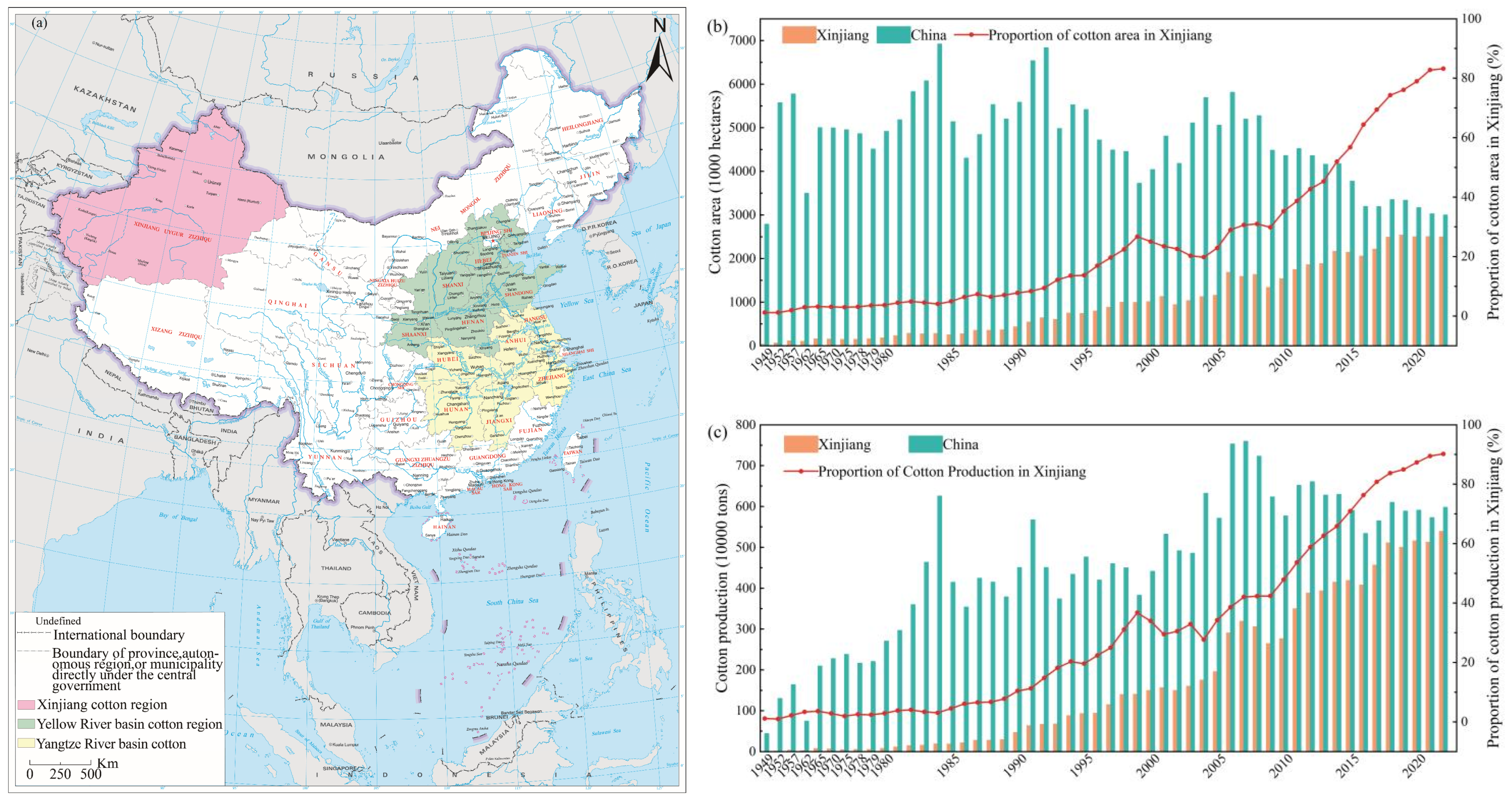
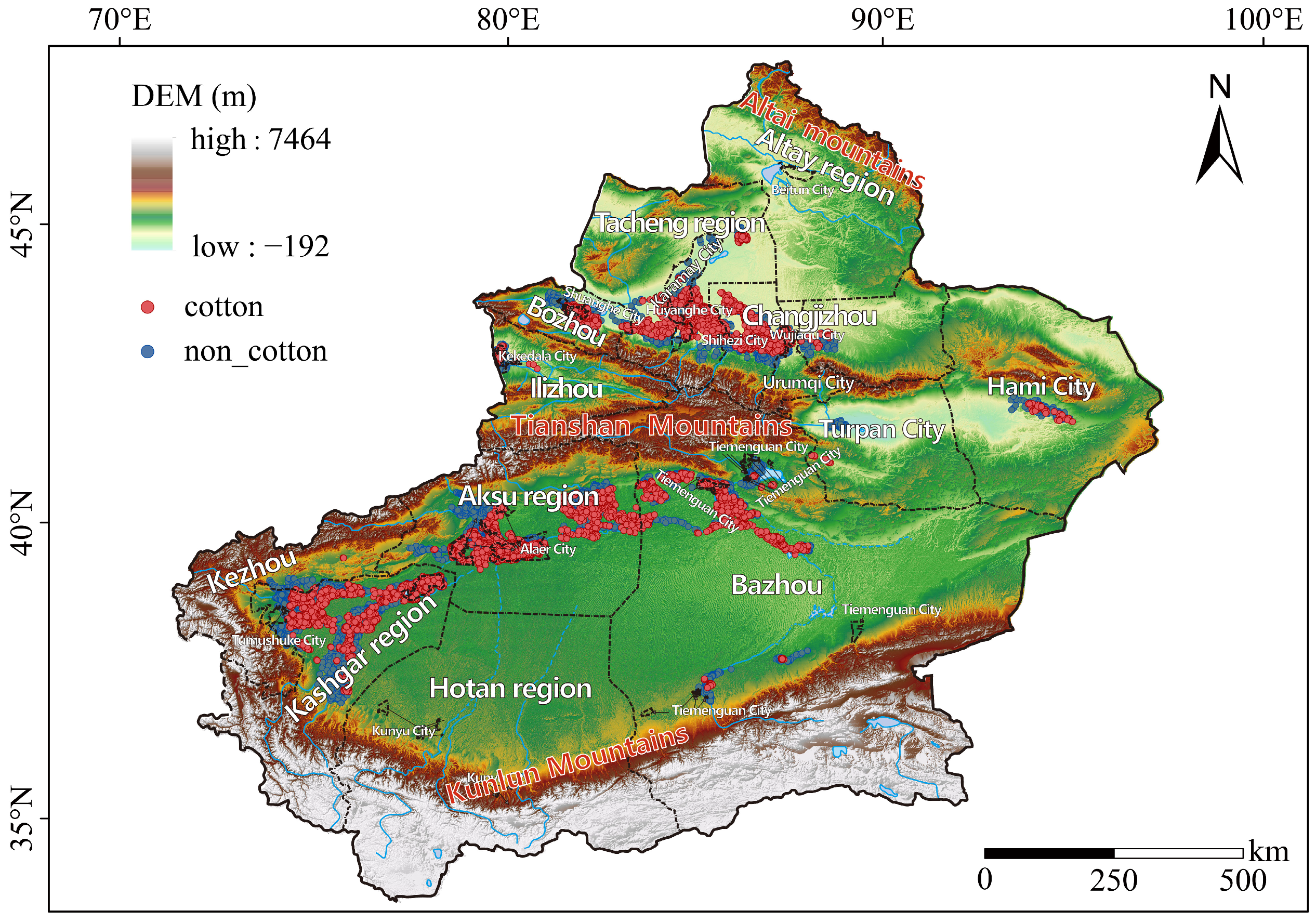

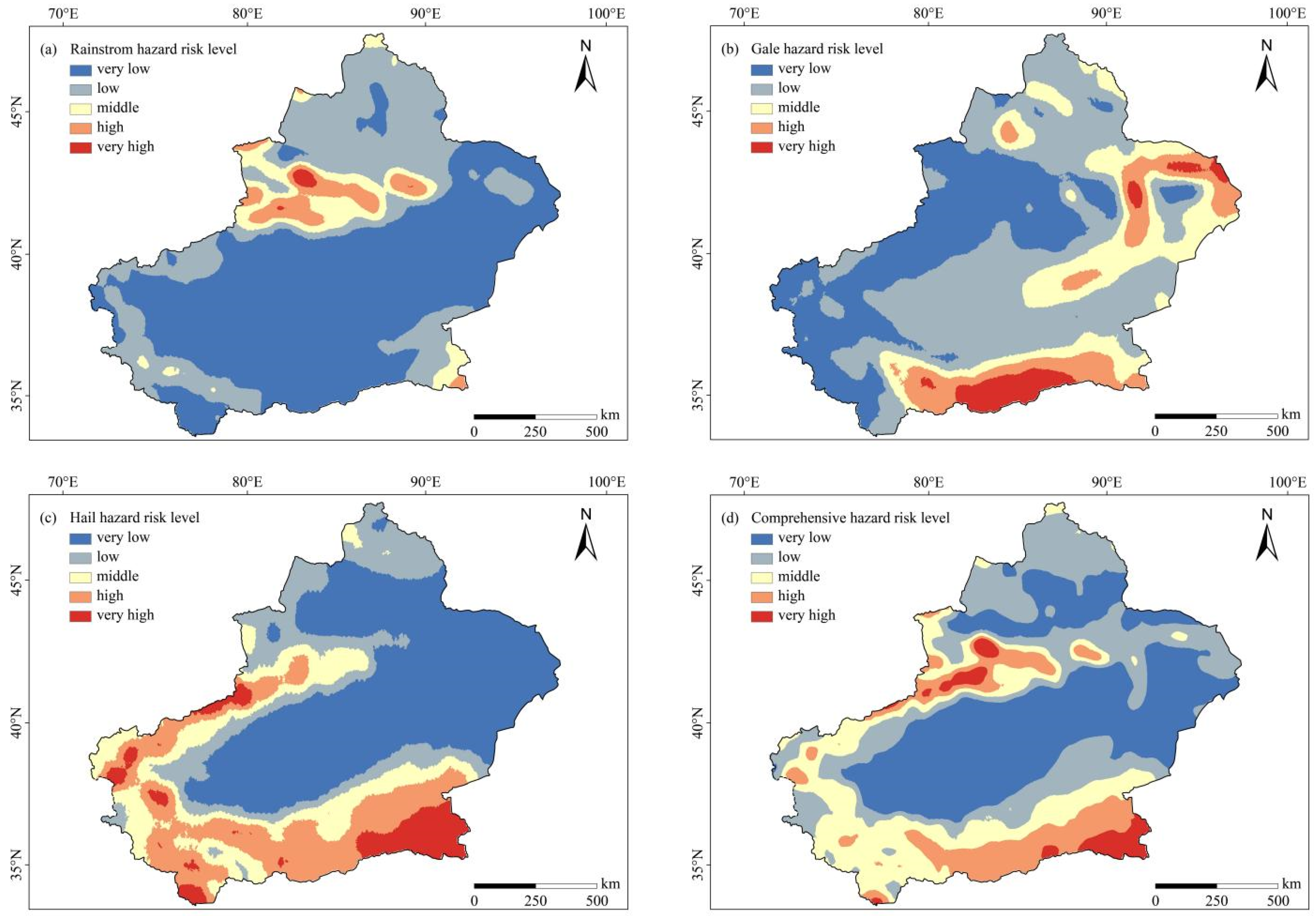
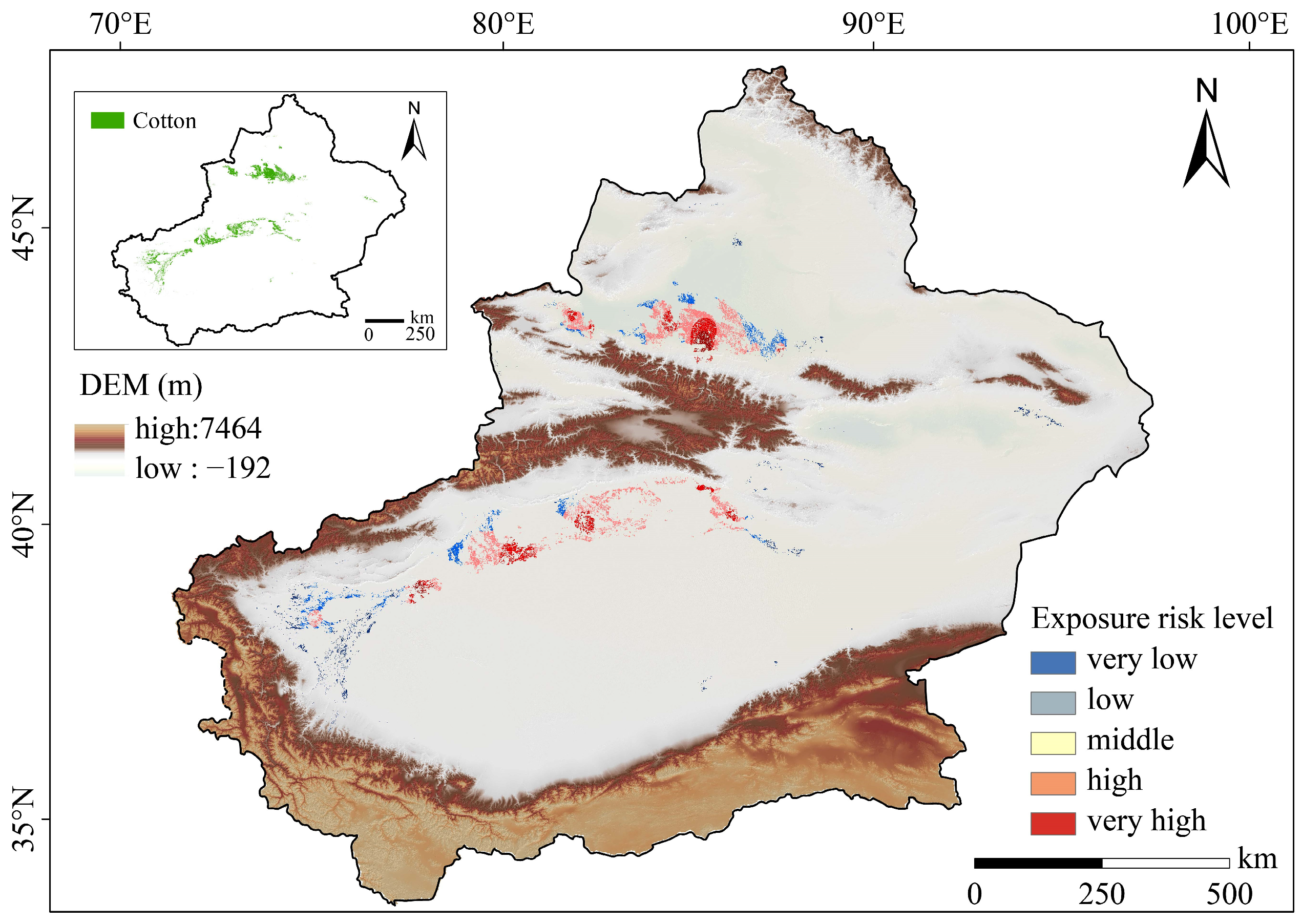
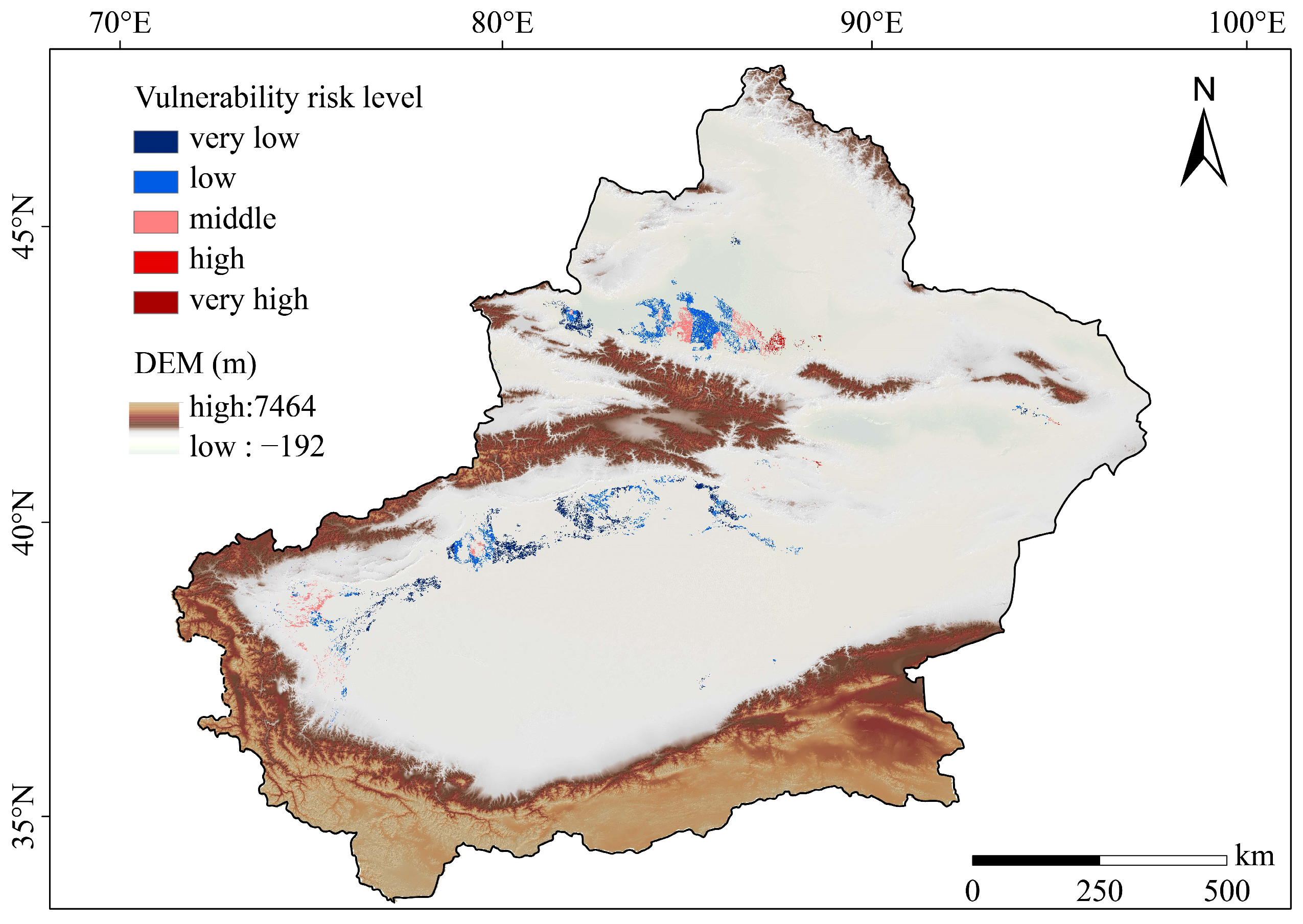
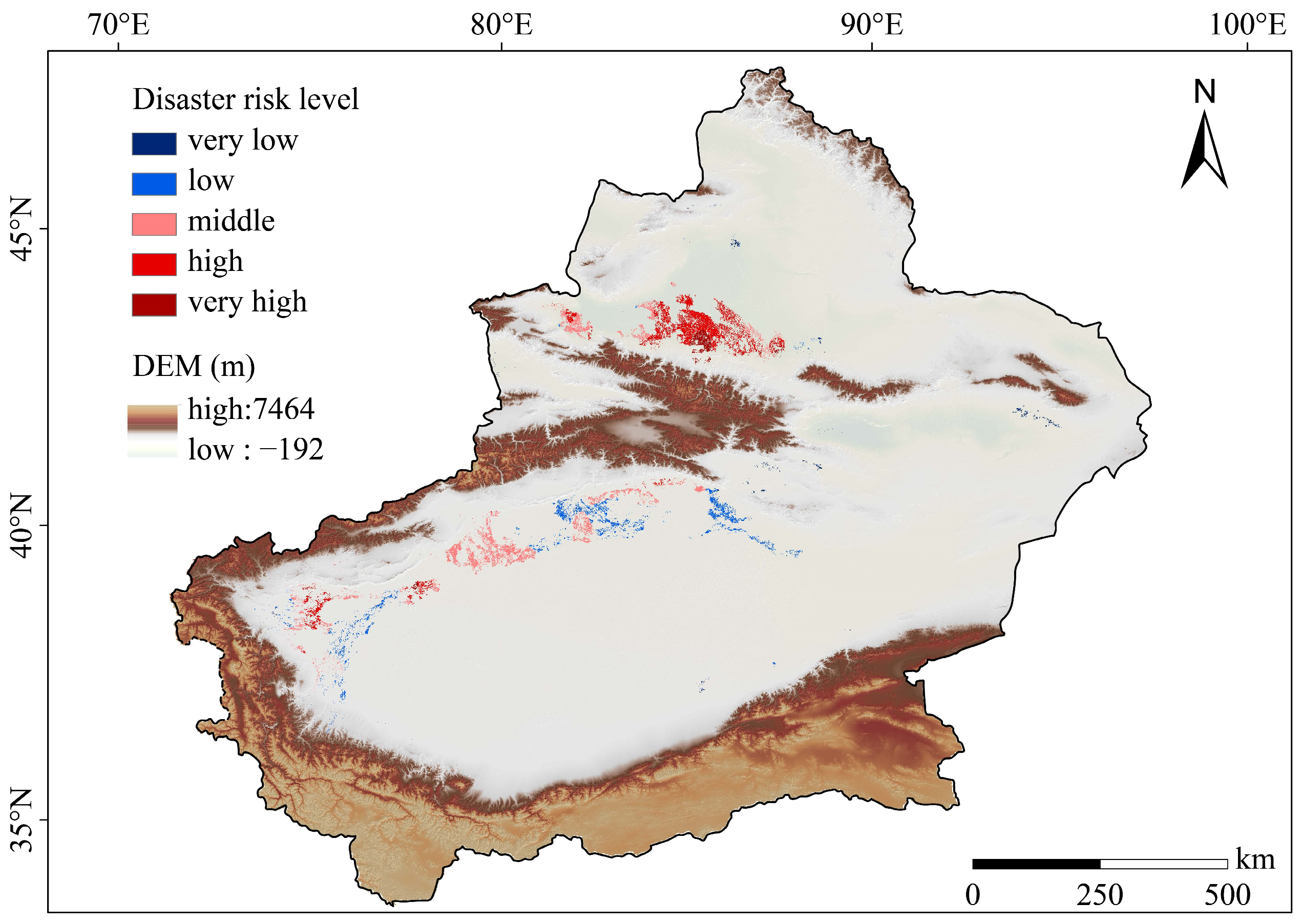
| Parameter | Type | Time | Sources | Resolution |
|---|---|---|---|---|
| Rainstorm data | Meteorological data | 1981–2020 | GEE: CHIRPS Daily: Climate Hazards Group InfraRed Precipitation with Station Data (Version 2.0 Fina) | 0.05° |
| Gale data | Meteorological data | 1981–2020 | GEE: ERA5-Land Hourly—ECMWF Climate Reanalysis | 11,132 m |
| ERA5 hourly data on single levels from 1940 to present——Instantaneous 10 m wind gust | 0.25° | |||
| Hail data | Meteorological data | 1981–2020 | ERA5 hourly data on single levels from 1940 to present——Precipitation type | 0.25° |
| Land use/Land cover change | Remote sensing product data | 2020 | The 30 m annual land cover dataset and its dynamics in China from 1990 to 2019 | 30 m |
| Sentinel-2 | Remote sensing product data | 2020 | GEE: Sentinel-2 MSI: MultiSpectral Instrument, Level-2A | 10 m |
| MOD13Q1 | Remote sensing product data | 2020 | GEE: MOD13Q1.061 Terra Vegetation Indices 16-Day Global 250 m | 250 m |
| Cotton yield | Socioeconomic data | 2001–2020 | Xinjiang Statistical Yearbook | County-level |
| Xinjiang Production and Construction Corps Statistical Yearbook | ||||
| Digital elevation model (DEM) | Remote sensing product data | 2000 | Resource and Environment Data Cloud Platform | 90 m |
| Target Layer | Factor Layer | Sub-Factor Layer | Indicator Layer |
|---|---|---|---|
| Comprehensive risk assessment of meteorological disasters of cotton in Xinjiang | Hazard of disaster-causing factors (H) | Rainstorm (Hr) | Annual number of rainstorm days (Hr1) |
| Annual rainstorm amount (Hr2) | |||
| Annual rainstorm maximum (Hr3) | |||
| Gale (Hg) | Annual number of gale days (Hg1) | ||
| Annual hourly maximum gale wind speed (Hg2) | |||
| Annual instantaneous maximum gale wind speed (Hg3) | |||
| Hail (Hh) | Annual number of hail days (Hh1) | ||
| Exposure of disaster-bearing bodies (E) | Cotton distribution (cotton planting area)/cropland area (Fa) | ||
| Vulnerability of disaster-bearing bodies (V) | Yield reduction rate (P) |
| Factor Layer | Indicator Layer | Very Low | Low | Medium | High | Very High |
|---|---|---|---|---|---|---|
| H | Hr1 | (0, 1] | (1, 2] | (2, 4] | (4, 7] | (7, 12] |
| Hr2 | (24.1, 48.38] | (48.38, 92.89] | (92.89, 165.73] | (165.73, 291.17] | (291.17, 540.02] | |
| Hr3 | (0.37, 25.41] | (25.41, 46.88] | (46.88, 74.30] | (74.30, 116.03] | (116.03, 304.43] | |
| Hg1 | (0, 9] | (9, 23] | (23, 42] | (42, 64] | (64, 93] | |
| Hg2 | (1.73, 5.89] | (5.89, 9.25] | (9.25, 12.36] | (12.36, 14.92] | (14.92, 22.11] | |
| Hg3 | (11.56, 17.21] | (17.21, 20.15] | (20.15, 22.51] | (22.51, 25.12] | (25.12, 33.04] | |
| Hh1 | (0, 9] | (9, 21] | (21, 34] | (34, 48] | (48, 85] | |
| E | Fa | (0, 0.07] | (0.07, 0.18] | (0.18, 0.3] | (0.3, 0.44] | (0.44, 0.88] |
| V | P | (0, 2.21] | (2.21, 3.97] | (3.97, 5.79] | (5.79, 8.51] | (8.51, 14.47] |
| Factor Layer | AHP | EWM | Comprehensive Weight | Sub-Factor Layer | AHP | EWM | Comprehensive Weight | Indicator Layer | AHP | EWM | Comprehensive Weight |
|---|---|---|---|---|---|---|---|---|---|---|---|
| H | 26% | 34% | 30% | Hr | 64% | 54% | 59% | Hr1 | 64% | 53% | 59% |
| Hr2 | 26% | 40% | 33% | ||||||||
| Hr3 | 10% | 7% | 8% | ||||||||
| Hg | 10% | 15% | 12% | Hg1 | 73% | 77% | 75% | ||||
| Hg2 | 19% | 16% | 18% | ||||||||
| Hg3 | 8% | 7% | 7% | ||||||||
| Hh | 26% | 31% | 29% | Hh1 | 1 | 1 | 1 | ||||
| E | 64% | 53% | 58% | Fa | 1 | 1 | 1 | ||||
| V | 10% | 13% | 12% | P | 1 | 1 | 1 | ||||
| Name | Very Low | Low | High | Very High |
|---|---|---|---|---|
| Aksu Administrative Offices | 0% | 28% | 0% | 0% |
| Bayangol Mongol Autonomous Prefecture | 6% | 68% | 4% | 0% |
| Kashgar Administrative Offices | 0% | 33% | 34% | 2% |
| Hotan Administrative Offices | 100% | 0% | 0% | 0% |
| Kizilsu Kirgiz Autonomous Prefecture | 8% | 18% | 50% | 0% |
| Bortala Mongol Autonomous Prefecture | 0% | 0% | 22% | 0% |
| Changji Hui Autonomous Prefecture | 1% | 2% | 78% | 3% |
| Hami City | 100% | 0% | 0% | 0% |
| Ili Kazak Autonomous Prefecture | 0% | 0% | 61% | 0% |
| Karamay City | 0% | 0% | 94% | 1% |
| Tachen Administrative Offices | 1% | 0% | 68% | 19% |
| Turpan City | 100% | 0% | 0% | 0% |
| XinJiang/Total | 2% | 19% | 37% | 5% |
Disclaimer/Publisher’s Note: The statements, opinions and data contained in all publications are solely those of the individual author(s) and contributor(s) and not of MDPI and/or the editor(s). MDPI and/or the editor(s) disclaim responsibility for any injury to people or property resulting from any ideas, methods, instructions or products referred to in the content. |
© 2024 by the authors. Licensee MDPI, Basel, Switzerland. This article is an open access article distributed under the terms and conditions of the Creative Commons Attribution (CC BY) license (https://creativecommons.org/licenses/by/4.0/).
Share and Cite
Zhang, P.; Chen, Z.; Ding, G.; Fang, J.; Fan, J.; Li, S. Spatial Analysis and Risk Assessment of Meteorological Disasters Affecting Cotton Cultivation in Xinjiang: A Comprehensive Model Approach. Sustainability 2024, 16, 4938. https://doi.org/10.3390/su16124938
Zhang P, Chen Z, Ding G, Fang J, Fan J, Li S. Spatial Analysis and Risk Assessment of Meteorological Disasters Affecting Cotton Cultivation in Xinjiang: A Comprehensive Model Approach. Sustainability. 2024; 16(12):4938. https://doi.org/10.3390/su16124938
Chicago/Turabian StyleZhang, Ping, Zhuo Chen, Gang Ding, Jiaqi Fang, Jinglong Fan, and Shengyu Li. 2024. "Spatial Analysis and Risk Assessment of Meteorological Disasters Affecting Cotton Cultivation in Xinjiang: A Comprehensive Model Approach" Sustainability 16, no. 12: 4938. https://doi.org/10.3390/su16124938
APA StyleZhang, P., Chen, Z., Ding, G., Fang, J., Fan, J., & Li, S. (2024). Spatial Analysis and Risk Assessment of Meteorological Disasters Affecting Cotton Cultivation in Xinjiang: A Comprehensive Model Approach. Sustainability, 16(12), 4938. https://doi.org/10.3390/su16124938






